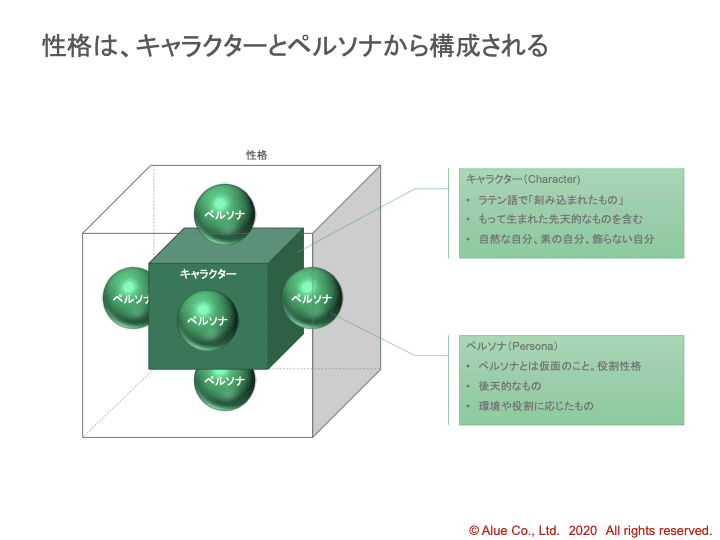
相手の「性格」に合わせた育成とは?
前回の記事では、部下の「学習」を導くパートナーとなるために、部下が経験学習サイクルを回すための支援をしていくこと大切さと、その方法についてお話しました。
ここまでの記事では、人材育成について全ての人に通じうる本質に焦点を当ててきました。一方で、現実には一人ひとり「性格」が違うので、実際のコミュニケーションや指導内容は人によって変えていく必要があります。
今回の記事では、部下の性格に合わせて育成するための方法についてお話しします。
「性格」とは何か?
「性格」という言葉は日常生活でもよく使いますが、より深く理解する上で、私は「キャラクター」と「ペルソナ」にわけて整理をしています。

「キャラクター」とは、持って生まれた素の自分を指します。それに対し「ペルソナ」は環境や役割に応じた役割性格を指します。役割性格というのは聞き慣れない言葉ですが、メタファーを用いて表現すれば「素顔を隠すことができる仮面」です。
図の通り、素の自分であるキャラクターが真ん中にあって、その周辺のいくつかのペルソナを場面によって使い分けているイメージです。「仮面」と言うと、本来のものを隠すというニュアンスが強くでてしまい否定的なイメージを持つかもしれませんが、ペルソナは人が社会生活を営む上で必要不可欠のものです。
一般的な意味での性格は、キャラクターだけを連想しがちだと思います。でも、ここではキャラクターとペルソナが合わさったものを性格と捉えることがポイントです。

人は場面やコミュニティに応じていくつかのペルソナを使い分けますが、ペルソナの形成や表出の仕方も含めて、その人の性格なのです。
キャラクターとペルソナのバランス
素の自分のキャラクターを出しつつ、周囲とどう調和するか、悩んだことのある人も多いのではないでしょうか。
このようなキャラクターとペルソナのバランスに悩むことは、ある意味では自然なものです。先程もお伝えした通り、ペルソナがなければ、社会生活を営むのは困難です。一方で、キャラクターがない状態も、自分を押し殺すような感覚になってしまいます。
キャラクターとペルソナは両方必要であり、自分にとって望ましいバランスを見つけ、そのバランスを維持していくことが大切になります。ちょうど良いと思うバランスが、心の発達によって変わっていくこともあります。そのような場合は、より望ましいバランスに変化させていくことも大切なことになります。

その望ましいバランスは人によって異なりますが、一般的には、キャラクターが無理なく表出できる一方で、キャラクターをさらけ出す不安感が強すぎない状況が良いと言えるでしょう。
部下に接する時には、部下の性格にはキャラクターに相当するものと、ペルソナに相当するものがあることを理解しつつ、キャラクターが押し殺されずに自然に表出できているかどうかを気にかけると良いでしょう。
キャラクターが自然に表出できている状態であれば、本人の個性が言葉の使い方や表情や仕草に自然と現れてきます。逆に、キャラクターが押し殺されている状態ですと、言葉の使い方や表情が固く、個性と感じるというよりも、無難に振る舞おうとしている印象を受けます。
キャラクターが自然に表出できていないからといって、本人のキャラクターを無理に出させようとしてはいけません。逆効果です。無理に出させようとすればするほど、ペルソナを厚くして対処しようとすることでしょう。
キャラクターが自然に表出できていない部下がいたとしても、まずは部下の性格(キャラクターとペルソナ)をあるがままに理解することから始めると良いでしょう。いい・悪いではなく、あるがままを受け止めることがポイントです。そのような受容性を部下の方が感じることができれば、キャラクターを表出するハードルが少しずつ下がっていきます。

「エゴグラム」による性格把握
さて、ここまで性格にはキャラクターとペルソナがあるということをお伝えしましたが、部下の性格に応じて、どのようにコミュニケーションや指導をしていくかという話をしたいと思います。
性格検査には、さまざまなものがありますが、ここではエゴグラムをご紹介します。
エゴグラムとは、エリック・バーン氏とジョン・M・デュセイ氏が考案した性格診断法で、人の心を5つの特性に分類して計測するものです。5つの分類は、次のような内容です。

分類に ”Child” ”Parent” という言葉が使われている通り、「親」と「子」でイメージするとわかりやすいです。
FC(Free Child):「自由な子ども」
AC(Adopted Child):「順応的な子ども」
CP(Critical Parent):「厳格な親」
NP(Nurturing Parent):「寛容な親」
※A(Adult)は「中立的な大人」のイメージ
これは当社独自の解釈ですが、エゴグラムの5つの特性は、先ほどのキャラクターとペルソナの図と合わせて解釈することもできます。

”Child” の2タイプ(FCとAC)は「自分自身」のキャラクターとペルソナの持ち方を表します。FC(自由な子ども)は自分自身キャラクターを出す特性、一方で、AC(順応的な子ども)はペルソナを作って順応する特性です。
”Parent” の2タイプ(CPとNP)は「相手に対して」どのようなキャラクターとペルソナの持ち方を促すかを表します。CP(厳格な親)はペルソナを作り周囲に順応させようとする特性、NP(寛容な親)は本人のキャラクターを大切にしようとする特性です。
他にも有名な性格診断としてMBTI(Myers–Briggs Type Indicator)やストレングスファインダーなどがありますが、これらは「他の人と比較した自分自身の性格の特徴」に焦点を当てているイメージです。
それに対し、エゴグラムは「自分と相手」という枠組みで性格を捉えている点が特徴的です。人材育成のように1対1の関係性を考える上で相性がいいので、今回ご紹介しました。
部下との関係性において生じやすい課題をエゴグラムで捉えておく
育成の観点では、自分と相手のエゴグラム特性によって、起こり得るコミュニケーションの課題を類型化して捉えておくことが有効です。
育成される側の ”Child” のタイプと、育成する側の ”Parent” のタイプの組み合わせによって、大まかに次のようにコミュニケーションの課題を整理できます。

例えば、上司の心的特性がCP優位(厳格な親>寛容な親)であり、部下の心的特性がAC優位(従順な子供>自由な子供)の場合、コミュニケーション上でぶつかる可能性は低いですが、周囲の環境への適応を双方ともに重視するために、部下のキャラクターの表出ができず、個性が磨かれにくかったり、エネルギーが枯渇してしまったりするリスクがあります。
このような場合は、部下のありのままを受容して、そのキャラクターが自然と引き出されるような関わりをしていくことが有効かもしれません。
ちなみに、これは上司と部下の関係だけではなく、親子の関係にも言えることです。
部下の性格は、自分とは異なることを大前提とした上で、部下の性格を理解することから始め、キャラクターとペルソナの望ましいバランスが実現できるように、コミュニケーションの仕方を工夫していただければと思います。
本日の問いとなります。(よろしければ、コメントにご意見ください)
・あなたの部下や後輩は、FC(自由な子供)とAC(順応な子供)のどちらが優位に見えますか?上司としてのあなたは、CP(厳格な親)とNP(寛容な親)のどちらが優位でしょうか?(ここでは、ご自身の感覚で直感的に捉えていただいて大丈夫です。正しく知りたい方は、正式に検査を受けていただくことをお勧めします)
・上記の組み合わせの場合、コミュニケーション上どのような課題が生じる可能性があるでしょうか?
Developing people in accordance with their personality
In my last article, I discussed the importance of supporting subordinates in their experiential learning cycle and how to be a partner in guiding their learning.
In the previous articles, we have focused on the essence of people development, which can be applied to everyone. On the other hand, in reality, each individual has a different "personality," so the actual communication and supervision needs to be different for each person.
In this article, I will discuss how to develop your subordinates according to their personalities.
What is personality?
The term "personality" is often used in everyday life, but for a deeper understanding, I divide it into "character" and "persona" to organize it.

Character refers to the true self that one is born with. A persona, on the other hand, refers to a role personality that is appropriate to one's environment and role. Role personality" is an unfamiliar term, but using a metaphor, it is a "mask that can hide one's true face."
As shown in the figure, there is a character in the center, which is the true self, and several personas around the character, which are used in different situations. The word "mask" may have a negative image because it strongly implies the nuance of hiding one's true self, but personas are indispensable for people to live a social life.
In a general sense, we tend to associate personality only with character. But the point here is to think of personality as the combination of character and persona.
People use several personas depending on the situation or community, but it is their personality that includes the way they form and express their personas.
Balance between character and persona
Many of us have probably struggled with how to blend in with our surroundings while still maintaining our true character.
This struggle to balance character and persona is, in a sense, natural. As I mentioned earlier, without a persona, it is difficult to live a social life. On the other hand, the absence of character also makes us feel like we are pushing ourselves away.
Both character and persona are necessary, and it is important to find and maintain a balance that is desirable for you. Sometimes the balance that feels just right will change as the mind develops. In such cases, it is important to change to a more desirable balance.
The desirable balance will vary from person to person, but in general, a situation in which the character can be expressed without strain, while not being too anxious to expose the character, is desirable.
When dealing with subordinates, it is a good idea to understand that there are two types of personalities, one corresponding to the character and the other to the persona, and to pay attention to whether or not the character is being expressed naturally without being overwhelmed.
If the character is naturally expressed, the individual's personality will naturally appear in the use of words, facial expressions, and gestures. On the other hand, if the character is stifled, the use of words and facial expressions will be stiff, giving the impression that the person is trying to play it safe, rather than giving the impression of individuality.
Do not try to force a person to express his or her character just because the character is not naturally expressed. It is counterproductive. The more you try to force the character out, the more he/she will try to cope with the situation by thickening the persona.
Even if you have a subordinate whose character is not naturally expressed, it is a good idea to start by understanding his/her personality (character and persona) as it is. The key is to accept them as they are, not as good or bad. If the subordinate can feel such acceptance, the hurdle to expressing character will be gradually lowered.
Personality analysis using the Egogram
Now that I have told you that there are two types of personalities, character and persona, I would like to talk about how to communicate and guide your subordinates according to their personalities.
There are many different personality tests available, but here I would like to introduce the Egogram.
The Egogram is a personality diagnostic method developed by Eric Berne and John M. Dusay that measures a person's mind by classifying it into five characteristics The five categories are as follows.

As the words "Child" and "Parent" are used in the classification, it is easy to understand the image using the metaphor of "parent" and "child".
This is my own interpretation, but the five characteristics of the Egogram can also be interpreted in conjunction with the character and persona diagram described earlier.

"Child" two types (FC and AC) represent how one carries one's own character and persona: FC (Free Child) tends to give out one's own character, while AC (Adapted Child) tends to create a persona and conform.
The two types of "Parent" (CP and NP) represent the type of character and persona that one encourages the other to have: CP (Critical Parent) is the tendency to create a persona and adapt to the surroundings, while NP (Nurturing Parent) is the tendency to value the character of an individual.
Other well-known personality tests include MBTI (Myers-Briggs Type Indicator) and StrengthsFinder, but these images focus on "one's own personality traits compared to others.
In contrast, the Egogram is unique in that it captures personality within the framework of " self and others. I introduce it here because it is a good match for considering one-to-one relationships, such as people development.
Use Egogram to identify challenges that are likely to arise in relationships with subordinates
From the perspective of people development, it is useful to typify and capture possible communication challenges based on the Egogram characteristics of you and your subordinates.
By combining the "Child" type of the subordinate and the "Parent" type of the supervisor, we can roughly organize communication challenges as follows.

For example, if the supervisor's mental characteristic is CP-oriented and the subordinate's mental characteristic is AC-oriented, there is little chance of conflict in communication, but because both parties focus on adapting to the surrounding environment, the subordinate's character is not expressed and his/her personality is not refined or his/her energy is depleted.
In such cases, it may be effective to accept the subordinate as he/she is and relate to him/her in such a way that his/her character is naturally brought out.
This is true not only for the relationship between a supervisor and subordinate, but also for the relationship between a parent and child.
I hope that you will start by understanding your subordinate's character, based on the basic premise that his/her character is different from yours, and then devise a way to communicate with him/her so that the desired balance between character and persona can be achieved.
Here are the quests of the day. (If you'd like, please share your thoughts in the comments.)
・Do your subordinates appear to be more dominant FC or AC? As a supervisor, do you see yourself as more dominant in CP or NP? (If you want to know correctly, I recommend that you take a formal test)
・What communication challenges might arise with the above combination?
Bunshiro Ochiai
この記事が気に入ったらサポートをしてみませんか?
